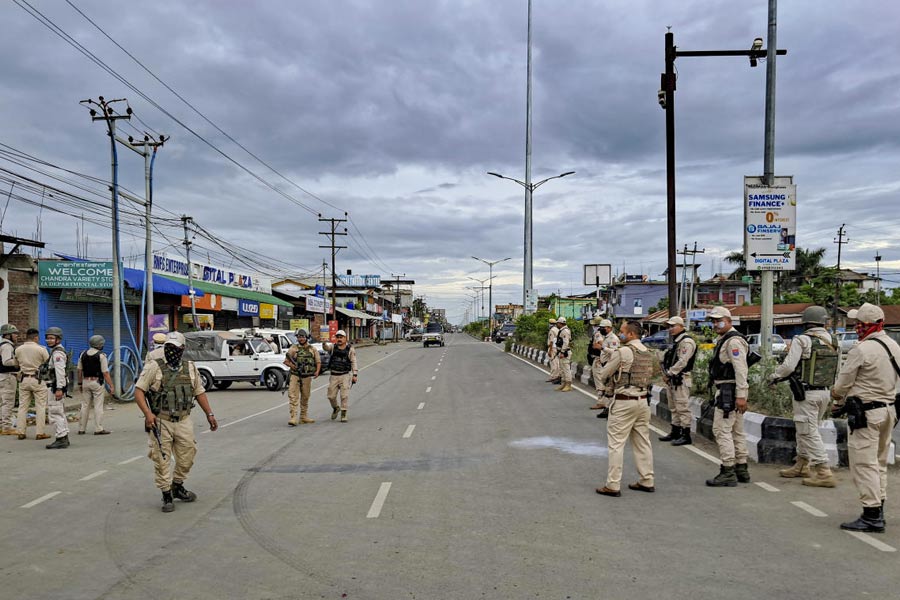
Manipur’s terra infirma stakeholders must realise the need to come to terms with the new reality of sedentary lifestyle
Don't Miss
- 'Operation Sindoor': JeM's communication network concealed in Pakistan's Sarjal destroyed
- RETALIATION : India Avenges Pahalgam Attack : Strikes 9 Terror targets in Pak, PoK under OPERATION SINDOOR
- Operation Sindoor: NSA Ajit Doval declares India ready to “retaliate resolutely” if Pakistan escalates tensions
If and when the ongoing Manipur crisis reaches an amicable resolution, the stakeholders must realise the need to come to terms with the new reality of sedentary lifestyle
Pradip Phanjoubam, TT, 24.01.24: One insight into the ongoing ethnic conflict in Manipur and, indeed, the periodic explosion of similar violence in most other northeastern states is the problem posed by widely different notions of land and its ownership amongst different communities. It is ironic but illustrative that there are so many boundary disputes among these states; admittedly, the notion of the modern boundary was unknown here before the Treaty of Yandabo of 1826 by which the British annexed Assam and merged it with Bengal.
As Lord Curzon pointed out in his Romanes lecture in 1907 on ‘Frontiers’, it was in not only the Northeast but also the world outside of Europe where the idea of artificially delineated boundaries was alien. There were natural boundaries determined by rivers, mountains, deserts and so on, but even these did not resemble the closely-guarded and precise limits of national domains. Boundaries also waxed and waned, depending on the powers of rulers and chiefs.
The British being unaccustomed to territories with no precise limits ensured boundaries were drawn wherever they took over. While these boundaries served their purposes, they often left problems for those who inherited them. This history of the Northeast’s boundaries is intriguing and the land-people relationship also complicated British boundary-making exercises in many ways.
The British administrative institution introduced in Assam reflected the challenges of dealing with a mix of State-bearing populations under centralised bureaucracies of kingdoms and non-State communities living in the uncharted hills. Assam’s plains were much easier for the British to handle, unlike the hills where the authority of each village, tribe and clan did not run beyond its closed community. The British, therefore, introduced normal land revenue administration in the plains but left the surrounding hills as Excluded or Partially Excluded areas and separated the two regions by an Inner Line drawn by the Bengal Eastern Frontier Regulation of 1873. In 1907, the British also introduced a similar administrative arrangement in their protectorate state of Manipur.
That communities living in different kinds of economy would have different outlooks towards land is a foregone conclusion. For the nomads, anywhere they pitch their tents is their land. But this is not so for settled agriculturists, feudal principalities or the modern State. When communities with different outlooks towards land live in the same geographical region, conflicts are inevitable. One of Manipur’s major problems is this.
What needs to be remembered is that the modern State is premised on a sedentary and enumerable population. Democracy itself would become fragile if its population were to be constantly shifting, with government infrastructure perpetually chasing proliferating villages.
If and when the Manipur crisis reaches an amicable resolution, the stakeholders must realise the need to come to terms with the new reality of sedentary lifestyle. This will transform the endemic land tussles among Manipur’s diverse communities as well as those with the State. While indigenous ways of life must be respected, a common denominator is also indispensable to ensure good administration.
The Manipur government must also reconsider its practice of giving recognition to new villages periodically. Because of a peculiar land-holding tradition amongst — especially — the Kukis, whereby the chief owns the village and the villagers are landless, there is a tendency for villagers to leave and start their own village. This is also one reason why Kukis felt most targeted when the government initiated an eviction drive against encroachment in reserved and protected forests. Neighbouring Mizoram, where Kuki-Zo kindred tribes live, can be a shining example. Following the introduction of the Sixth Schedule of the Constitution, the autocratic rights of 259 chiefs were abolished on popular demand in 1954, giving stability to its villages.
Pradip Phanjoubam is editor, Imphal Review of Arts and Politics


0 Response to "Manipur’s terra infirma stakeholders must realise the need to come to terms with the new reality of sedentary lifestyle"
Post a Comment
Disclaimer Note:
The views expressed in the articles published here are solely those of the author and do not necessarily reflect the official policy, position, or perspective of Kalimpong News or KalimNews. Kalimpong News and KalimNews disclaim all liability for the published or posted articles, news, and information and assume no responsibility for the accuracy or validity of the content.
Kalimpong News is a non-profit online news platform managed by KalimNews and operated under the Kalimpong Press Club.
Comment Policy:
We encourage respectful and constructive discussions. Please ensure decency while commenting and register with your email ID to participate.
Note: only a member of this blog may post a comment.